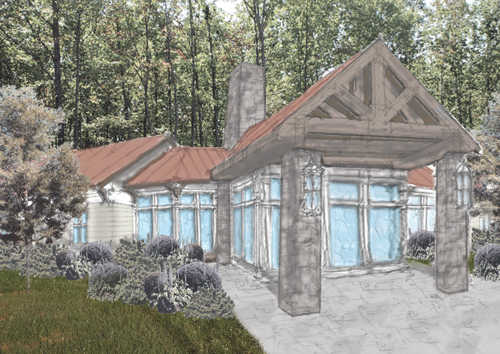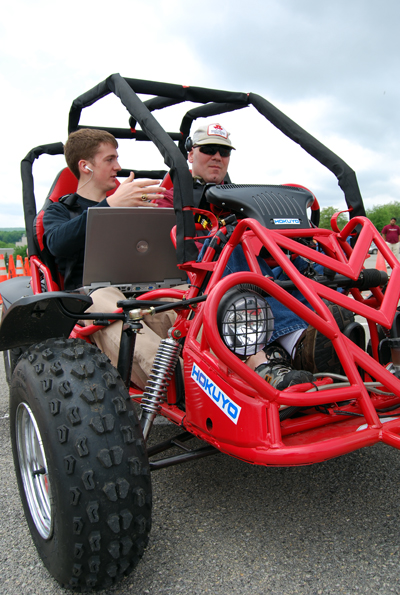|
|
|
|
|
|
|
 |
Donations pave
the way for 4-H
welcome center
by ALBERT RABOTEAU
|
|
|
|
|
|
|
|
|
|
|
Each year, thousands of young people attend programs at the W.E. Skelton 4-H Educational Conference Center at Smith Mountain Lake.
One reason they go is obvious. Who wouldn't want to spend time on a beautiful, 120-acre property that offers boating, horseback riding, robotics, and other exciting activities? But another reason is that the programs are affordable.
Skelton 4-H center officials are able to charge campers just half of what it actually costs to provide camp programs because the center also has revenue from a donor-supported endowment and from groups that book conferences at the facility when camp is not in session.
"The conference business allows us to stay true to why we are here, which is to help 4-H camping," says Roger Ellmore, the center's executive director.
Now that business is poised to grow, thanks to donors who have contributed more than $1.6 million toward construction of a 7,200-square-foot welcome center. When it opens in 2011, the new building will make the 4-H center, located in Wirtz, Va., even more attractive to people looking for a site for conferences, retreats, or weddings.
Officials say that increasing their conference business is not only important because of the revenue it brings in directly, but also because of the visibility it gives the center, which helps in fundraising overall.
The 4-H center is named for William E. Skelton, a former director of the state's 4-H program and dean of Extension at Virginia Tech, who died in 2008. Much of the cost of the new building will be covered by an estate gift he made.
|
|
|
|
|
|
|
"[My father] was all about giving people, especially youth, an opportunity that they might not otherwise have had to better themselves."
|
|
|
|
|
|
|
|
|
|
|
"[My father] was all about giving people, especially youth, an opportunity that they might not otherwise have had to better themselves. I wanted to be a part of this effort," says John Skelton, who serves on the center's board and also donated generously toward the project.
"I am excited about this project because it will help to enhance the center even more for this region," says Garnett Smith, who, along with his wife, Patsy, made a significant donation to the project. Smith has served on the center's board for more than 30 years.
Board member John Montague and his wife, Jean Skelton Montague, William E. Skelton's daughter, contributed substantial funding as well. "In the spirit of giving, we are hoping that our contributions, as well as my brother's, will help to enrich the lives of our youth and to continue the exceptional work being done at the 4-H Center at Smith Mountain Lake," Jean says.
To learn more about the W.E. Skelton 4-H Educational Conference Center at Smith Mountain Lake, including naming opportunities in its welcome center, call Doug McAlister at 540/231-6913.
|
|
|
|
|
Gifts-in-kind spur education and research
by ALBERT RABOTEAU
|
|
|
|
 |
|
Greg Jannaman (mechanical engineering '09) had to go through five interviews and give a technical presentation to land his spot in the engineering leadership program at National Instruments, a company that Fortune has consistently listed as one of the nation's 100 best places to work.
Fortunately for Jannaman, he was unusually well prepared. During his senior year, he led an undergraduate team that designed a laser-based navigation system that allows blind drivers to steer a dune buggy around a road course.
Several companies, including National Instruments, donated the equipment that made it possible for the Blind Driver Challenge team to complete a working prototype.
Jannaman calls the exercise "the most valuable experience I had in college by far" and says it helped prepare him for the job at National Instruments. "I was kind of worried during my interviews that I was talking about it too much," Jannaman says of his work with the Blind Driver Challenge team, "but not only was it a technically applicable experience with their products, it showed leadership."
National Instruments is one of many companies that have made significant gifts-in-kind--donations of software, equipment, or other valuable materials--that benefit students and faculty at Virginia Tech.
Without such donations, many projects simply would not be possible. For example, gifts-in-kind totaling more than $2 million have gone into a hybrid electric vehicle that students are entering in the North America EcoCAR challenge--gifts ranging from the vehicle itself, an SUV from General Motors, to $87,000 worth of parts from battery manufacturer A123 Systems.
|
|
|
Steven Mackay
|
|
|
|
|
|
|
Greg Jannaman (left) with Patrick Johnson, a graduate student in special education administration, behind the wheel. Jannaman was part of a student team that developed a vehicle for the Blind Driver Challenge. |
|
|
|
|
|
|
|
|
|
|
"We need the commitment from the major competition sponsors along with local sponsors to be able to do a prototype vehicle," says Lynn Gantt (mechanical engineering '09), who worked as a graduate research assistant and will start an internship with General Motors in June.
Andrew McCoy, an assistant professor of building construction in the College of Architecture and Urban Studies, says gifts-in-kind were also crucial for the Lumenhaus team, which designed an 800-square-foot solar house full of energy-saving equipment.
"Without contributions, I just think we would have been limited [in our design]," says McCoy, a core faculty advisor for the project. "Donations let us be able to push as many envelopes as we could ..., and that's a real nice thing to do."
Sixty-five companies from a wide range of industries were involved in the Lumenhaus project, which gave many team members an opportunity to interact with professionals in their field, McCoy adds.
Gifts-in-kind are also invaluable to the Joseph F. Ware Jr. Advanced Engineering Lab. Dewey Spangler manages the lab, a 10,000-square-foot facility where many undergraduate engineering teams, including the Blind Driver Challenge crew, work on their projects. He says corporations are eager to support student design teams "because the students who are trained here at Ware Lab go out into the engineering professions ready to design, ready to be productive in the workplace."
From a recruiting standpoint, it's to a company's advantage to get its equipment into the hands of students who could not otherwise access it. "If we could generate enough interest there at Virginia Tech in using some of our software, it would make sense for us to then recruit those users already familiar with our applications. That would be a real benefit to us," says Matt Heric (Ph.D. educational research '96), CEO of IAVO Research and Scientific.
IAVO donated 125 licenses for its GeoGenesis image processing software, which would have cost more than $3.8 million to buy outright. The software was designed to help the Department of Defense target weapons but is also useful in a wide range of geographic-information-systems applications.
Though companies may reap some benefits from their donations, that is not the only reason they give. Executives often say that supporting education is a worthwhile goal in itself. "In our collective mind here [at IAVO], we've got the philosophy that if the school can use the software and it helps them fulfill their mission to the students, then go for it," says Heric.
Another perk for companies is that such donations help establish relationships with researchers whose work could help industry, says John Hole, an associate professor of geosciences in the College of Science. His department has received both software licenses and geological data sets that could be used in research with implications for energy exploration.
"None of us are finding oil here in academia, but we're doing work that is closely related," Hole says. "We're either using the same tools in [geological] imaging, which is what I do, or are looking at layering of sediments in marine or river environments, which is what a couple of other professors in this department do. We are able to use similar tools in our own research problems, whether that is data sets or software."
Visit www.campaign.vt.edu/connect for more stories on how donations are helping Virginia Tech invent the future.
|
|
|
|
|
|
|
|
| ALBERT RABOTEAU is a writer for University Development. |
|
|
|
|
|
|

